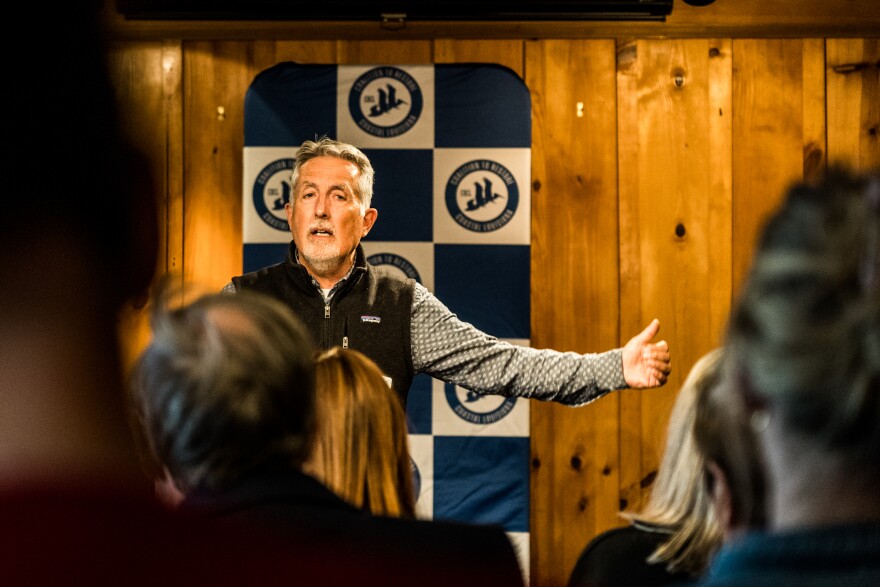Two decades ago, author Mike Tidwell spent months in Louisiana’s Bayou Country, meeting with Cajuns, Vietnamese immigrants and Native Americans who make up the cultural landscape of the region. As he immersed himself in the food, music and traditions of the community, the residents warned him that their culture was at risk of disappearing due to the environmental challenges the state was facing.
When “Bayou Farewell: The Rich Life and Tragic Death of Louisiana’s Cajun Coast” was released in 2003, it was a groundbreaking look at Louisiana’s land loss crisis, an issue that was rarely covered by national outlets at the time.
Now, Tidwell has revisited the region that influenced his book for its 20-year anniversary to see what’s changed, stayed the same and how the land loss crisis has been addressed. The author joined coastal reporter Kezia Setyawan for a discussion on his trip back to the state two decades later.
The following conversation has been edited for clarity and brevity:
Kezia Setyawan: For those who don’t know, what is “Bayou Farewell” about?
Mike Tidwell: My editor at the Washington Post in 1999 asked me to go to Louisiana and write whatever I wanted. And I wound up with this idea of hitchhiking on Cajun fishing boats up and down the bayous of south Louisiana.
I talked my way onto the shrimp boat of a gentleman named Papoose Ledet, who took me halfway between Golden Meadow and the Gulf of Mexico.
I went shrimping with his family and worked as a deckhand on his boat. Then, he dropped me off in Leeville, where I then caught a ride with a 17-year-old crabber named Tee Tim to Port Fourchon.
And then I turned around and did the same thing from Bayou Petit Caillou in Chauvin all the way to the Gulf.
These fishermen told me don't get too attached to this land and this culture because they’re passing away and they’re about to be wiped out.
And I said, “What do you mean?” And they said, “Look at the telephone poles in the water along the roads. Look at the cemeteries that are underwater in places like Leeville.” These tombs were half-submerged in water.
They explained to me the land is sinking, and the water is rising, and we're going to be wiped out.
So that's why I wrote the book Bayou Farewell.
I wanted to give this disappearing land and culture a voice to tell the rest of America we need to save this. The book came out in 2003, and then sure enough, Katrina came in 2005. A lot of people still read the book in south Louisiana and across the country; the story is still meaningful. We still have to save this coast, but we're making some progress.

KS: It's been over 20 years since the book has been published, and you've since retraced your steps. What changes jumped out to you?
MT: In the early 2000s, not many people outside of Louisiana had any idea about the coastal land that the state was losing at the time — an area of land the size of Delaware had been subtracted from South Louisiana since the 1930s.
And that's because the land is sinking in a natural way, at the same time that we prevent the Mississippi River from flooding with the massive levees that we put on it.
When you shackle that river and send all her muddy sediments over the edge of the continental shelf, there's no more land building that happens, and the land is still sinking.
So that's why so much of South Louisiana is disappearing. And in the early 2000s, very few people — even in Louisiana — fully understood the problem. Now 20 years later, a lot more people have awareness throughout Louisiana and across much of the country.
But not much is being done even now. You know, there's the Mid-Barataria Sediment Diversion that’s an engineering plan to divert some water from the Mississippi River into the Barataria Basin. It will create land, but we need to do a lot more.
KS: You said previously that this book turned you into a climate activist? Could you tell us more about how that book did that, and what does being a climate activist mean to you?
MT: The science around climate change was sound, and enough people knew what was happening. But the oil industry was denying their role in it. And by the way, they played a big role in dredging 10,000 miles of canals through the wetlands, accelerating the erosion.
In the early 2000s, there was enough evidence that it was happening, but no one was really paying attention, and it scared me.
If it's happening here, if this whole community of south Louisiana is leaning into a knockout punch because of ecological decline, where else is it happening?
And that's when I realized we're all New Orleanians all over the world because of sea level rise, because of climate change.
I founded a nonprofit up here in the Mid-Atlantic called the Chesapeake Climate Action Network in 2002. So even though I'm up here in the DC area, I'm advocating for national and global clean energy solutions that will also benefit south Louisiana.
KS: Could you tell us about some of the people that you wrote about and who you were able to reconnect with all these years later?
MT: In April I spent several days just retracing my original steps in my book, tracking down some of the fishermen that I wrote about.
I had the amazing experience of finding a good friend of mine named Papoose Plaisance, who's a member of the United Houma Nation. He lives in Grand Bois, but fishes out of Pointe-aux-Chenes.

Over 20 years ago, I worked as a deckhand on his shrimp boat, and we spent many nights in his camp out in the wetlands. We would shrimp at night, sleep during the day in his camp.
He's 50 years old now. He was 27 when I met him and wrote about him, and his son now has taken over the tradition of shrimping. His 23-year-old son just bought a 56-foot trawler, shrimps out in the Gulf, shrimps in the wetlands and is continuing that tradition. So that's exciting.
I met some other shrimpers and crabbers who were not as fortunate. A guy named Timmy Melancon from Leeville and his wife Phyllis are featured prominently in the book. Unfortunately, their house was completely wiped out by Hurricane Ida.
People in this country know about Katrina. They know about the Gulf Oil Spill, but people outside of Louisiana have no idea how bad Hurricane Ida was for south Louisiana.
Most of the homes in the community of Leeville on Bayou Lafourche were completely annihilated, including the Melancons. And now they've had to retreat. They're like refugees who've had to move further up the bayou to Golden Meadow.
Another friend named Papoose Ledet, a shrimper in Golden Meadow, has stopped shrimping because it's just harder. There’s higher fuel costs, the price to sell shrimp is low and there’s imports of shrimp from Asia. These are all pressures that didn't quite exist 20 years ago, and it's made it harder for people to make a living.
KS: There was an interesting point that you brought up in a previous conversation, how some of the characters in your book are actually on the frontlines of the clean energy shift. Could you touch upon that?
MT: On this trip, I was really encouraged that at least two people that I write about in the book are now involved in the offshore wind industry. One is a kid named Tee Tim Melancon. At the beginning of this book, Tee Tim was 17 years old and was a crabber.
All these years later, he’s now an executive for the Edison Chouest shipbuilding company, and he's working on a ship that will be used in the Northeast to repair and maintain offshore wind turbines.

Traditionally, Chouest has built ships for the oil and gas industry, and now they're building ships for offshore wind. The company is using Cajun ingenuity, engineering and maritime experience to now build ships that are going to bring a new era of clean energy to America and the planet.
Another friend, Loulan Pitre Jr., from down the bayou, is a practicing lawyer in New Orleans.
I wasn't able to see him on the recent trip because he was in Denmark learning about offshore wind turbines. He's working as an attorney for companies who want to build offshore wind in the Gulf of Mexico. I'm glad to see that clean energy is starting to really penetrate the Louisiana economy.
KS: What do you think still needs to be done to address coastal land loss, and what have the people you've met say is still missing in this fight?
MT: If we're really going to address coastal land loss in Louisiana, we have to do multiple things in a hurry.
One, we have to let the Mississippi River rebuild land. We have to have controlled diversions where you literally just punch a hole in the levees of the Mississippi River and put dam-like structures that, in a controlled way, will let water out and all those sediments that are in it. We need to guide that water to the shallow bays and coastal areas that will rebuild wetlands and barrier islands.
Two, we've got to stop climate change. No matter how many diversions you build, no matter how high you build the levees around New Orleans and elsewhere … we have to slow down and eventually stop sea level rise worldwide from climate change if south Louisiana is going to survive.
I think that what's missing is the resources. The BP oil spill settlement has provided the resources to build this first river diversion that is going to build a lot of land. But beyond that, there's got to be more committed resources from the state and the federal government. And people all over the country need to understand that this is not just a Louisiana problem — this is a United States of America problem.
So much of our energy comes from this coast. So much of our seafood still comes from coastal Louisiana. The great cultures of New Orleans, Cajun Creole, the music, the food: We have to preserve this not only for south Louisiana, but for the benefit of all Americans now and in the future. We need everyone to pitch in.



